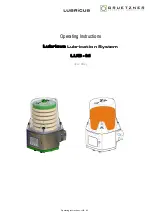
4
15. DO NOT OVERREACH. Keep proper footing and balance at all times. Wear oil-resistant rubber-soled foot-
wear. Keep the floor clear of oil, scrap, and other debris.
16. MAINTAIN TOOLS PROPERLY. ALWAYS keep tools clean and in good working order. Follow instruc-
tions for lubricating and changing accessories.
17. CHECK FOR DAMAGED PARTS. Check for alignment of moving parts, jamming, breakage, improper
mounting, or any other conditions that may affect the tool’s operation. Any part that is damaged should be properly
repaired or replaced before use.
18. MAKE THE WORKSHOP CHILDPROOF. Use padlocks and master switches and ALWAYS remove start-
er keys.
19. DO NOT operate the tool if you are under the influence of drugs, alcohol, or medication that may affect your
ability to properly use the tool.
20. USE SAFETY GOGGLES AT ALL TIMES that comply with ANSI Z87.1. Normal safety glasses only have
impact resistant lenses and are not designed for safety. Wear a face or dust mask when working in a dusty environ-
ment. Use ear protection such as plugs or muffs during extended periods of operation.
GENERAL SAFETY RULES
1. To reduce the risk of injury and electric shock hazards, disconnect the air filtration system from the power source
before servicing or changing filters.
2. If mounting the air filtration system to the ceiling:
• Make sure the bottom of the air filtration system is at least 7 feet above the floor level.
• Anchor the air filtration system only to building structures capable of holding at least 100 lbs.
• Do not anchor the filtration system to non-structural components such as drywall, false ceiling panels, etc.
3. Position the air filtration system so that it is at least 3 feet away from any corner or from any heating, cooling, or
air circulation vents.
4. This filtration system is only designed to filter dust, small particles, etc. Do not use the air filtration system in
environments that have poisonous gases, fumes, noxious smoke, or other chemical risks.
5. Do not expose the air filtration system to water. Do not use in wet or damp environments. Failure to comply with
this instruction may cause damage to the unit and electric shock or other injury to the user.
6. Do not connect a power tool that expels waste or dust directly into the air filtration system. Doing so may damage
the unit.
7. This filtration system is designed to filter many airborne contaminants that may damage the human respiratory
system. However, the use of this system does not mean that other safety measures such as dust masks can be ig-
nored. Seek medical attention immediately if you experience any worrying respiratory symptoms.
SPECIFIC RULES FOR AIR FILTRATION SYSTEMS






























